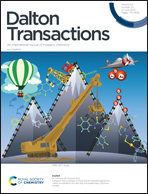Cobalt(ii) coordination to an N4-acenaphthene-based ligand and its sodium complex†
Abstract
A new bifunctional N4-ligand was obtained via the condensation reaction of acenaphthenequinone and 2-picolylamine. A peculiarity of this synthesis is the formation of a new intramolecular C–C bond during the reaction. The structure and redox properties of the ligand were studied. The anion-radical form of the ligand was prepared via the chemical reduction of the latter with metallic sodium as well as in situ via its electrochemical reduction in a solution. The sodium salt prepared was structurally characterized using single-crystal X-ray diffraction (XRD). New cobalt complexes with the ligand in neutral and anion-radical forms were synthesized and further studied. As a result, three new homo- and heteroleptic cobalt(II) complexes were obtained, in which the cobalt atom demonstrates different modes of coordination with the ligand. Cobalt(II) complex CoL2 with two monoanionic ligands was prepared by the electrochemical reduction of a related L2CoBr2 complex or by treating cobalt(II) bromide with the sodium salt. XRD was used to study the structures of all cobalt complexes prepared. Magnetic and electron paramagnetic resonance studies were performed: CoII ion states with S = 3/2 and S = 1/2 were found for the complexes. A quantum-chemical study confirmed that the spin density is mainly located at the cobalt center.



 Please wait while we load your content...
Please wait while we load your content...